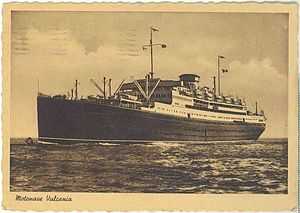MS Vulcania
 | |
| Career | |
|---|---|
| Name: | MS Vulcania |
| Owner: | Cosulich Line[1] |
| Port of registry: |
|
| Route: | Trieste - Naples - New York - Trieste |
| Builder: | Cantiere Navale Triestino, Monfalcone, Italy |
| Yard number: | 161[1] |
| Laid down: | 30 January 1926[1] |
| Launched: | 19 December 1926[1] |
| Completed: | 2 December 1928[1] |
| General characteristics | |
| Type: | Ocean liner |
| Tonnage: | 23,970 GRT[1] |
| Length: | 181.58 m (595 ft 9 in)[1] |
| Beam: | 24.31 m (79 ft 9 in)[1] |
| Height: | 14.17 m (46 ft 6 in)[1] |
| Propulsion: | 25,000 HP diesel engine[1] |
| Speed: | 19 kn (35 km/h)[1] |
| Capacity: | 1760 passengers |
The MS Vulcania was an Italian ocean liner built by Cantiere Navale Triestino, Monfalcone, northern Italy in 1926 for the Italian company, Cosulich Line.
Characteristics
She was a 23,970 gross ton ship, with an overall length of 181.58 m and a beam of 24.31 m.[1] She had one funnel, two masts, twin screw and could reach a maximum speed of 19 knots. There was accommodation for 310 First, 460 Second, 310 intermediate and 700 3rd class passengers. In 1930 her accommodation was altered to 1st, 2nd, tourist and 3rd class, and in 1962 to 1st, tourist and 3rd class only. In 1930 she was fitted with new diesel engines which gave her a speed of 21 knots and was rebuilt to a tonnage of 24,469 tons.
History
Launched on 18 December 1926, she sailed from Trieste on her maiden voyage to Patras, Naples and New York on 19 December of the same year. In December 1936 she commenced her last Trieste-New York voyage for Cosulich Line and in 1937 went to the newly formed Italia Line. In March 1937 she commenced running from Trieste to New York and in March 1940 commenced her last sailing Trieste - Naples - New York - Trieste. In May 1940 she made a single voyage to South America from Trieste to Buenos Aires, stopping in Naples, Genoa, Barcelona, Lisbon, Funchal, Bahia, Rio de Janeiro, Santos,[2] and was requisitioned by the Italian government in 1941 to carry troops to North Africa. In 1942-3 she was used on three special missions to repatriate women and children, Genoa - East Africa via South Africa.
In October 1943 she became a United States troopship and on 29 March 1946 was chartered to American Export Lines to run between New York - Naples - Alexandria. She commenced her last voyage on this service on 4 October 1946 after 6 round voyages and was returned to Italia Line on 15 November of that year. She then sailed New York - Naples - Genoa where she was reconditioned to carry 240-1st, 270-cabin and 860-tourist class passengers. In July 1947 she made a single voyage from Genoa to South America and then, on 4 September 1947, resumed the Genoa - Naples - New York service. On 21 September 1955 she commenced her last voyage on this run and on 28 October of the same year was transferred to run between Trieste, Venice, Patras, Naples, Palermo, Barcelona, Gibraltar, Lisbon, Halifax and New York. On 5 April 1965 she commenced her last voyage on this service and was sold to the Siosa Line who renamed her Caribia.
She arrived at Barcelona on 18 September 1973 under tow to be scrapped and departed under tow for Kaohsiung for scrapping on 15 March of the following year, but sunk before reaching the destination.[3]
Technology
The ship was powered by one of the largest two stroke diesel engines of its time. The cylinders was of the double-acting type, by which combustion took place both above and below the piston. This required the use of a crosshead.